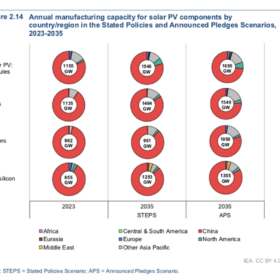British Columbia offers funding for First Nations renewables
The Canadian province of British Columbia has allocated CAD 7.7 million ($5.5 million) to projects in seven communities, including a 3.8 MW solar farm, energy storage, and a pre-feasibility study on hydrogen production.
Serbia sets maximum solar price of €72/MWh for second renewables auction
Serbia’s upcoming second renewables auction, scheduled for later this month, aims to procure 124.8 MW of solar power with a ceiling price of €72 ($75.30)/MWh. This price is lower than the €90/MWh ceiling offered in the country’s first renewables auction last year.
Greek researchers develop privacy-preserving PV forecasting technique
Researchers from Greece have developed a PV forecasting technique for prosumer schemes using federated learning, a machine learning method that sends local model updates to a central server for correction. Their simulations show surprising results compared to centralized forecasting.
Solar module manufacturing capacity could exceed 1.5 TW by 2035, says IEA
The International Energy Agency’s (IEA) latest report, which maps out the future evolution of clean energy manufacturing, says the combined global market for PV, wind turbines, electric cars, batteries, electrolyzers, and heat pumps will rise from $700 billion in 2023 to more than $2 trillion by 2035.
Sri Lanka to install rooftop solar at religious sites
Buddhist temples, churches, mosques and Hindu temples across Sri Lanka are receiving 5 kW rooftop solar installations free of charge. The project, backed by a $17 million investment from the Indian government, is expected to add 25 MW of solar to the grid.
Trinasolar Evergreen unveils BIPV products for industrial, public use
Trinasolar Evergreen (Shanghai) PV Tech. Co., Ltd., a building-integrated photovoltaics (BIPV) unit of Trina Solar, has launched four new products for public, industrial, and infrastructure projects. Trina Solar aims to capture a share of the fast-growing BIPV market.
The Outback communities embracing solar
Supporting First Nations people to effectively engage in and benefit from the energy transition is a timely priority for Australia’s emerging Net Zero Economy Authority, which is tasked with facilitating investments nationwide. pv magazine Australia’s Ev Foley finds the road to clean energy for remote communities can be long and hard, but possible. In the Pilbara, a First Nations group is blazing a trail as a developer of a 3 GW renewables pipeline.
IRENA calls for greater gender inclusion in decentralized energy sector
The International Renewable Energy Agency’s (IRENA) latest report says that women’s roles in decentralized renewable energy are critical to achieving universal electricity access in underserved communities.
Off-grid solar appliance repair training a must for remote communities
An Australian Research Council funded report co-authored by Sydney-based University of New South Wales and UK-based charity SolarAid says the off-grid solar sector should do more to enhance its product repair initiatives.
PV-driven lighting solution for rural areas
Scientists have created a lighting system based on the AEM10941 solar harvester developed by Belgium-based E-peas. The system is reportedly able to provide a full brightness run time of 10 hours.










